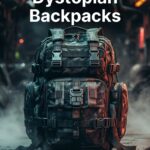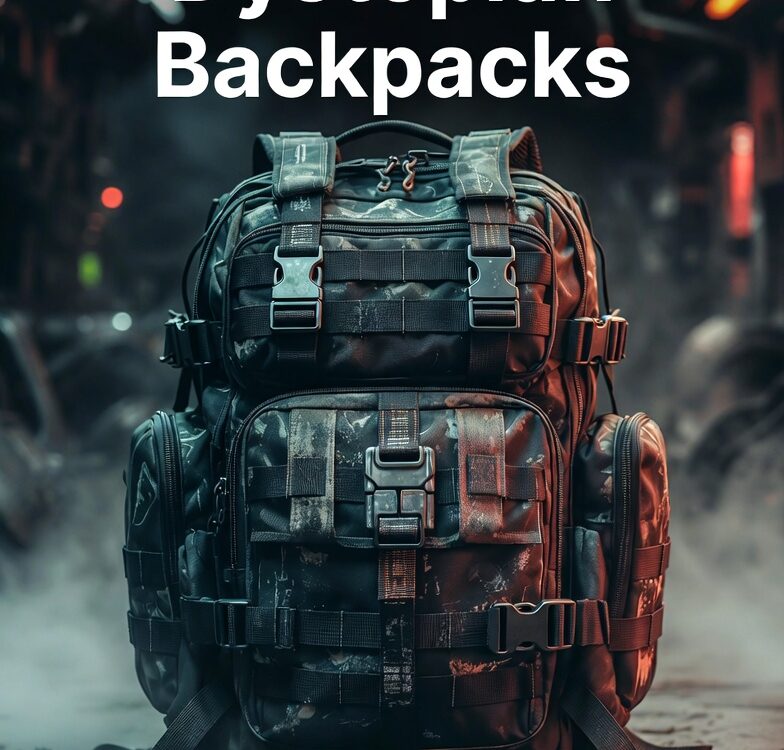
Dystopian Backpacks: Gear for an Uncertain Future
November 16, 2025
Cyberpunk Helmets and Visors: A Guide to the Future of Headwear
November 17, 2025Face coverings have woven themselves into the fabric of human history for reasons spanning from health and religion to celebration and protest. Yet, a particular style has emerged from the pages of science fiction and the pixels of video games to capture our collective imagination: dystopian face masks. These are not your average surgical masks; they are bold statements, blending aesthetics with speculative function, reflecting anxieties and aspirations about the future.
This article explores the compelling world of dystopian face masks. We will look at their origins in popular culture, their transition into high fashion and wearable technology, and what their growing popularity says about our modern society. From artistic expression to concerns about surveillance and environmental collapse, these masks represent a unique intersection of art, technology, and social commentary.
What Defines a Dystopian Face Mask?
At its core, a dystopian face mask is a piece of facial wear that evokes themes of a bleak or oppressive future. Unlike simple protective gear, these masks are characterized by their complex, often intimidating designs. They frequently incorporate elements like respirators, glowing LEDs, sharp geometric angles, and industrial materials. The aesthetic is often a mix of cyberpunk, military-tech, and post-apocalyptic survival gear.
The purpose extends beyond simple function. A dystopian face mask can be a symbol of rebellion against a controlling regime, a necessary tool for survival in a polluted world, or a way to reclaim identity in an era of mass surveillance. It transforms the wearer, creating an anonymous, powerful, or even menacing persona. These masks make a statement about the world they hypothetically belong to—one often marked by technological overreach, environmental disaster, or social decay.
From Science Fiction to Street Style
The concept of the dystopian face mask was largely born in speculative fiction. Books, films, and video games have given us some of the most iconic examples, shaping our visual understanding of what a dark future might look like.
Iconic Examples in Media
Think of characters like Immortan Joe’s followers in Mad Max: Fury Road, with their menacing, skull-like respirator masks designed for a world choked by dust. Consider the stormtroopers of Star Wars, whose helmets create a faceless, uniform army for an oppressive empire. Video games like Cyberpunk 2077 and Death Stranding are filled with characters whose facial tech serves both practical and aesthetic purposes in their respective futures.
These portrayals have cemented the dystopian face mask as a powerful visual shorthand. They immediately signal a world that is different from our own—often one that is more dangerous and technologically saturated. They represent a loss of individuality in favor of uniformity or a rugged adaptation to a harsh new environment.
The Rise in Techwear and High Fashion
What was once confined to the screen has now found a firm footing in the real world. The techwear movement, a fashion subculture focused on futuristic, functional clothing, has enthusiastically adopted the dystopian face mask. Brands and independent designers create masks using advanced materials and manufacturing techniques like 3D printing. These pieces are not just props; they are functional works of art.
High fashion has also embraced the trend. Designers on runways from Paris to Tokyo have incorporated elaborate, futuristic face coverings into their collections. These pieces challenge our ideas of beauty and accessories, often serving as a commentary on contemporary issues. The dystopian face mask in fashion is a provocative statement, blurring the lines between clothing, technology, and political art.
The Cultural Meaning Behind the Mask
The growing interest in dystopian face masks is not just a fleeting trend. It reflects deeper societal currents and anxieties about the path we are on. The mask becomes a canvas for expressing complex ideas about our present and future.
Anxieties About the Environment
One of the most powerful themes connected to these masks is environmental collapse. Many designs feature prominent respirators, air filters, and tubing, suggesting a world where the air is no longer safe to breathe. This resonates strongly with current concerns about air pollution, climate change, and industrial waste. Wearing such a mask can be a form of protest or a grim acknowledgment of a potential reality we hope to avoid.
Surveillance and the Fight for Anonymity
In an age of ubiquitous facial recognition technology and digital tracking, privacy is a major concern. The dystopian face mask offers a powerful counter-narrative. By obscuring the face, it becomes a tool for reclaiming anonymity and resisting a surveillance state. This connects to a long history of masks being used by protestors and activists to protect their identities. The futuristic design of a dystopian mask updates this tradition for the digital age, symbolizing a fight for individual freedom against technological control.
A Form of Self-Expression
Beyond the darker themes, creating and wearing a dystopian face mask is a powerful form of self-expression. For makers and artists, it is a medium to showcase their creativity and technical skill. They blend elements of engineering, sculpture, and fashion to build unique pieces of wearable art. For the wearer, it is a way to construct an identity, to stand out, and to align themselves with a particular subculture or aesthetic. It allows a person to project a persona that is strong, mysterious, and unapologetically futuristic.
The Technology Behind the Mask
Modern dystopian face masks are often marvels of design and technology. The methods and materials used to create them are as futuristic as the concepts they represent.
The Role of 3D Printing
3D printing has been a game-changer for independent designers and hobbyists. It allows for the creation of intricate, custom-fit designs that would be impossible to produce with traditional methods. Designers can prototype and iterate quickly, sharing their files online for others to print and modify. This has democratized the creation of high-quality dystopian face masks, fostering a vibrant global community of makers.
Integration of Electronics
Many contemporary designs go beyond static structures by integrating electronic components. This can include:
- LED Lighting: Customizable lights that can change color or pattern, adding a dynamic, cyberpunk feel.
- Fans and Filtration: Small, battery-powered fans to improve airflow and comfort, blurring the line between aesthetic and practical use.
- Voice Modulators: Devices that alter the wearer’s voice, enhancing the sense of transformation and anonymity.
These technological additions make the masks more interactive and bring the science fiction vision closer to reality. They are no longer just static props but active pieces of wearable tech.
Frequently Asked Questions (FAQs)
Q1: Are dystopian face masks legal to wear in public?
A: Laws regarding face coverings vary significantly by location. While wearing a mask for artistic or fashion purposes is generally acceptable, some jurisdictions have laws against concealing one’s identity in certain contexts, particularly during protests or in specific secure areas. It’s always best to check local regulations.
Q2: Are these masks effective as personal protective equipment (PPE)?
A: Most dystopian face masks are created as artistic or fashion pieces and are not medically certified for protection against viruses, pollutants, or industrial hazards. While some may incorporate filter slots or be worn over a standard protective mask, you should not rely on them for safety unless the manufacturer explicitly states they meet specific safety standards.
Q3: Where can I buy a dystopian face mask?
A: You can find them from various sources. Online marketplaces like Etsy have a large community of independent artists selling handmade masks. Specialized techwear brands also offer their own unique designs. Additionally, some creators share their 3D printing files on platforms like Thingiverse, allowing you to make your own if you have access to a 3D printer.
Q4: What is the difference between cyberpunk and dystopian aesthetics?
A: The two aesthetics often overlap but have distinct focuses. Cyberpunk typically involves a “high-tech, low-life” theme, focusing on advanced technology like cybernetics, neon-drenched cities, and corporate control. Dystopian is a broader category describing a society that appears perfect but is deeply flawed, often focusing on themes of oppression, environmental disaster, or loss of individuality. A mask can be both, but a cyberpunk mask will often feature more visible tech and electronic elements.
Final Words
The dystopian face mask is more than just a costume piece or a niche fashion accessory. It is a potent cultural object that reflects our times. It captures our anxieties about the future of our planet, our privacy, and our freedom, while also serving as a testament to human creativity and resilience. Through art, fashion, and technology, these masks allow us to “wear” our feelings about the world and imagine the roles we might play in a future of our own making.
Whether viewed as a warning, a statement, or a work of art, the dystopian face mask challenges us to think critically about the direction society is headed. It is a conversation starter, an identity-shaper, and a striking symbol of the intersection between imagination and reality.



